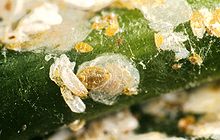Belarusians, also and Byelorussians, are an East Slavic ethnic group who are native to modern-day Belarus and the immediate region. There are over 9.5 million people who proclaim Belarusian ethnicity worldwide, with the majority residing either in Belarus or the adjacent countries where they are an autochthonous minority.

Lake Teletskoye is the largest lake in the Altai Mountains and the Altai Republic, Russia, and has depth up to 325 meters.

Staraya Ladoga ; Finnish: Vanha-Laatokka) is a rural locality in Volkhovsky District of Leningrad Oblast, Russia, located on the Volkhov River near Lake Ladoga, 8 kilometers (5.0 mi) north of the town of Volkhov, the administrative center of the district.
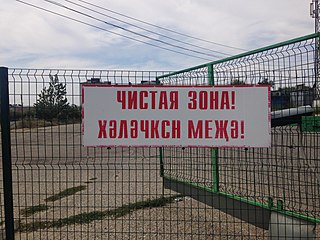
Kalmyk Oirat, commonly known as the Kalmyk language, is a register of the Oirat language, natively spoken by the Kalmyk people of Kalmykia, a federal subject of Russia. In Russia, it is the standard form of the Oirat language, which belongs to the Mongolic language family. The Kalmyk people of the Northwest Caspian Sea of Russia claim descent from the Oirats from Eurasia, who have also historically settled in Mongolia and Northwest China. According to UNESCO, the language is "Definitely endangered". According to the Russian census of 2010, there are 80,500 speakers of an ethnic population consisting of 183,000 people.
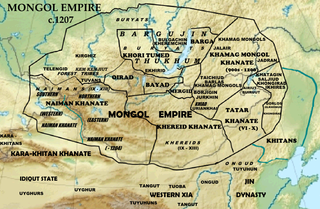
The Naiman is a medieval tribe originating in the territory of modern Western Mongolia, one of the tribes of modern mongols and in middle juz of Kazakh nation.

The Battle of Bolimów was an inconclusive battle of World War I fought on January 31, 1915 between Germany and Russia and considered a preliminary to the Second Battle of the Masurian Lakes.

Diaspididae is the largest family of scale insects with over 2650 described species in around 400 genera. As with all scale insects, the female produces a waxy protective scale beneath which it feeds on its host plant. Diaspidid scales are far more substantial than those of most other families, incorporating the exuviae from the first two nymphal instars and sometimes faecal matter and fragments of the host plant. These can be complex and extremely waterproof structures rather resembling a suit of armor. For this reason these insects are commonly referred to as armored scale insects. As it is so robust and firmly attached to the host plant, the scale often persists long after the insect has died.
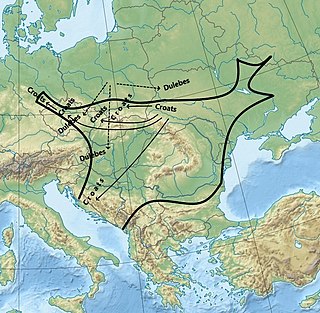
The Dulebes, Dulebs, Dudlebi or Dulibyh were one of the tribal unions of Early Slavs between the 6th and the 10th centuries. According to the medieval sources they lived in Western Volhynia, as well the Southern territory of Duchy of Bohemia and the Middle Danube between Lake Balaton and the Mur River in Principality of Hungary, probably implying migrations from a single region.

Diaspidinae is the largest subfamily of armored scale insects, with 252 genera.
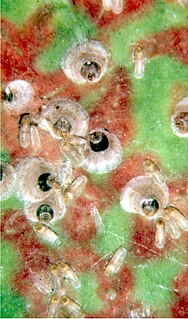
Parlatoriini is a tribe of armored scale insects. Takagi (2002) indicated that the Parlatoriini appear to be phylogenetically related to the Smilacicola and the Odonaspidini. Takagi went on to say about the tropical east Asian Parlatoriini that, The current classification of their genera may be largely tentative because the adult females are simple-featured and much modified owing to the pupillarial mode of life, and also because the second instar nymphs are generally similar among parlatoriines, whether the adult females are pupillarial or not. Andersen found that separating out pupillarial forms into a separate subtribe, Gymnaspidina, was counterproductive, as being non-dispositive.
Aspidiellina is a subtribe of armored scale insects. While the subtribe Aspidiellina was not mentioned in Takagi's 2002 study, the Aspidiotini were not deemed as problematical as the Diaspidini and Lepidosaphidini.
Furcaspidina is a subtribe of armored scale insects, traditionally regarded as part of the Aspidiotini. While the subtribe Furcaspidina was not mentioned in Takagi's 2002 study, the Aspidiotini were not deemed as problematical as the Diaspidini and Lepidosaphidini. In 2006, Williams reduced the Furcaspidina to a single genus, with about twenty-eight species. Andersen in 2009 suggested that the Furcaspidina belonged in an expanded subfamily of Diaspidinae; however, additional analysis suggests that the furcaspids are better placed in a distinct, but laterally equivalent subfamily to the Diaspidinae, possibly together with the gymnaspids which Borchsenius placed in the Aspidiotinae subfamily.
Augulaspidina is a subtribe of armored scale insects. It was not confirmed by Takagi's 2002 study.

Chionaspidina is a subtribe of armored scale insects established by Borchenius. But unlike many of the subtribes recognized by Borchenius, this one was found to be morphologically valid by Takagi. Similarly, in molecular analysis, Andersen et al. found a clade roughly corresponding to the subtribe Chionaspidina.
Rugaspidiotina is an obsolete subtribe of armored scale insects. It was established by Balachowsky in 1949 to accept those Diaspidinae which had rugaspidiotine characteristics as exemplified by genus Rugaspidiotus MacGillivray, species Rugaspidiotus arizonicus, and was moved from the Odonaspidini to the Diaspidini by Borchsenius. It was raised to tribe status as Rugaspidiotini. However, close examination of species assigned to the Rugaspidiotini showed that the rugaspidiotine characteristics convergently evolved in different groups of diaspidids. Rugaspidiotini and Rugaspidiotina are now regarded as obsolete groupings.
Sclopetaspidina is a subtribe of armored scale insects. It was not confirmed by Takagi's 2002 study.
Olga Nikolaevna Bondareva was a distinguished Soviet mathematician and economist. She contributed to the fields of mathematical economics, especially game theory.

There are several Azerbaijani people|Azerbaijani ethnic groups, each of which has particularities in the economy, culture and everyday life. Some Azerbaijani ethnic groups continued in the last quarter of the 19th century.
The House of Creativity "Staraya Ladoga" was an all-Russian centre for artistic creativity, which existed in the Volkhovsky District of Leningrad Oblast from the mid-20th century up to the 1990s. It was located opposite the ancient village of Staraya Ladoga on the right bank of the Volkhov River.

The Dolgan language is a Turkic language with around 1,000 speakers, spoken in the Taymyr Peninsula in Russia. The speakers are known as the Dolgans. The word "Dolgan" means 'tribe living on the middle reaches of the river'. This is most likely signifying the geographical location of the Dolgan tribe.
